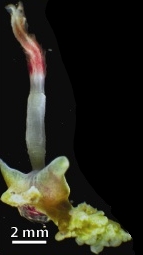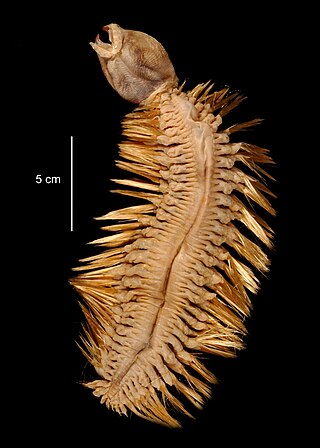Polychaeta is a paraphyletic class of generally marine annelid worms, commonly called bristle worms or polychaetes. Each body segment has a pair of fleshy protrusions called parapodia that bear many bristles, called chaetae, which are made of chitin. More than 10,000 species are described in this class. Common representatives include the lugworm and the sandworm or clam worm Alitta.

Osedax is a genus of deep-sea siboglinid polychaetes, commonly called boneworms, zombie worms, or bone-eating worms. Osedax is Latin for "bone-eater". The name alludes to how the worms bore into the bones of whale carcasses to reach enclosed lipids, on which they rely for sustenance. They utilize specialized root tissues for bone-boring. It is possible that multiple species of Osedax reside in the same bone. Osedax worms are also known to feed on the collagen itself by making holes in the whale's skeletal structure. These holes can also serve as a form of protection from nearby predators.
In biology, gonochorism is a sexual system where there are only two sexes and each individual organism is either male or female. The term gonochorism is usually applied in animal species, the vast majority of which are gonochoric.

Sequential hermaphroditism is one of the two types of hermaphroditism, the other type being simultaneous hermaphroditism. It occurs when the organism's sex changes at some point in its life. In particular, a sequential hermaphrodite produces eggs and sperm at different stages in life. Sequential hermaphroditism occurs in many fish, gastropods, and plants. Species that can undergo these changes do so as a normal event within their reproductive cycle, usually cued by either social structure or the achievement of a certain age or size. In some species of fish, sequential hermaphroditism is much more common than simultaneous hermaphroditism.

A hermaphrodite is a sexually reproducing organism that produces both male and female gametes. Animal species in which individuals are of different sexes, either male or female but not both, are gonochoric, which is the opposite of hermaphroditic.

Lysmata is a genus of shrimp in the infraorder Caridea, the caridean shrimp. The genus belongs to the family Lysmatidae. Lysmata are popular ornamental shrimp in the marine aquarium trade for their bright color patterns, interesting behaviors, and ability to control certain aquarium pests such as sea anemones of the genus Aiptasia. They are known to command high prices on the pet market.
Exallopus is a genus of polychaetes belonging to the family Dorvilleidae.

Sabellastarte spectabilis is a species of benthic marine polychaete worm in the Sabellidae family. It is commonly known as the feather duster worm, feather duster or fan worm. It is native to tropical waters of the Indo-Pacific but has spread to other parts of the world. It is popular in aquariums because of its distinctive appearance and its ability to remove organic particles and improve water quality.
Ophryotrocha scutellus, is a species of polychaete worm. Live observation of this species in aquarium experiments indicate a bacterial diet. O. scutellus is named after the Latin scutella for “saucer”, due to its flattened disc-like head. Ophryotrocha scutellus has a dorsoventrally rounded and flattened prostomium, similar to O. platykephale, from which this species differs in jaw morphology, the form of its parapodia and the absence of branchiae.
Ophryotrocha craigsmithi is a species of polychaete worm. O. craigsmithi is named after Craig R. Smith. This species is similar to Palpiphitime lipovskyae and O. Platykephale, among others, in having branchial structures dorsally and ventrally. It differs from O. platykephale in the shape of its prostomium and parapodia. Palpiphitime lipovskyae has jaws of both P- and K-type, while no specimens of O. craigsmithi have been found with K-type jaws thus far. Ophryotrocha craigsmithi differs from P. lipovskyae genetically, but also by the presence of a prominent ventral chaetal lobe with a bulging simple chaeta in the former.
Ophryotrocha eutrophila, is a species of polychaete worm. Ophryotrocha eutrophila is named after its habitat, liking organically enriched environments. This species resembles O. puerilis in jaw morphology. O. eutrophila is dimorphic, with males being than females, while possessing K-type maxillae. Ophryotrocha eutrophila, however, differs from O. puerilis in the absence of eyes and the presence of a developed median pygidial stylus. O. eutrophila is also similar to O. fabriae, differing from the latter from its mandibles morphology.
Ophryotrocha longicollaris is a species of polychaete worm, first found on deep sea whale fall and wood fall habitats in the north-east Pacific, off the southern Californian coast. This species and Ophryotrocha magnadentata are sister species; together with O. nauarchus and O. flabella, it falls in a clade including O. globopalpata and Exallopus jumarsi from the shallow North Atlantic.
Ophryotrocha magnadentata is a species of polychaete worm, first found on deep sea whale fall and wood fall habitats in the north-east Pacific, off the southern Californian coast. This species and Ophryotrocha longicollaris are sister species; together with O. nauarchus and O. flabella, it falls in a clade including O. globopalpata and Exallopus jumarsi from the shallow North Atlantic.
Ophryotrocha nauarchus is a species of polychaete worm, first found on deep sea whale fall and wood fall habitats in the north-east Pacific, off the southern Californian coast. The species is sexually dimorphic, males having appendages on their first chaetiger.
Ophryotrocha flabella is a species of polychaete worm, first found on deep sea whale fall and wood fall habitats in the north-east Pacific, off the southern Californian coast. It is similar to Ophryotrocha globopalpata, possessing some morphological differences, although genetic divergence is low between them.
Ophryotrocha langstrumpae is a species of polychaete worm, first found on deep sea whale fall and wood fall habitats in the north-east Pacific, off the southern Californian coast. It is closely related to Ophryotrocha scutellus and Ophryotrocha batillus.
Ophryotrocha batillus is a species of polychaete worm, first found on deep sea whale fall and wood fall habitats in the north-east Pacific, off the southern Californian coast. It is very similar to Ophryotrocha scutellus, yet differs from the latter genetically.

Phyllodocidae is a family of polychaete worms. Worms in this family live on the seabed and may burrow under the sediment.

Eulagisca gigantea is a species of scale worm. This species is specifically found in the deep-sea in cold waters like the Antarctic Ocean. The scale worms are named for the elytra on their surface that look like scales
Diopatra claparedii is a species of tube-building polychaete worm of the family Onuphidae. It is found dispersed along intertidal and subtidal benthic environments of South Asian waters, especially along the coasts of Malaysia, Singapore, Thailand, and the Philippines. This species is exploited by humans for fishing bait, indication of marine pollution, and as gold and silver nanoparticle biosynthesis agents.







